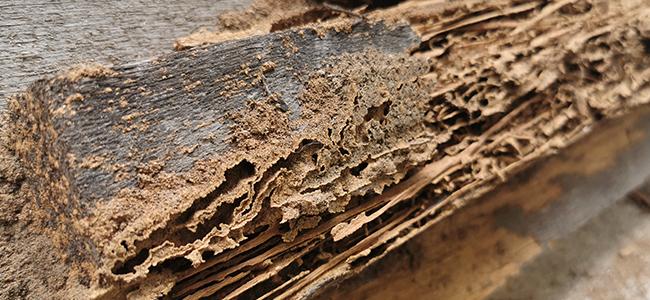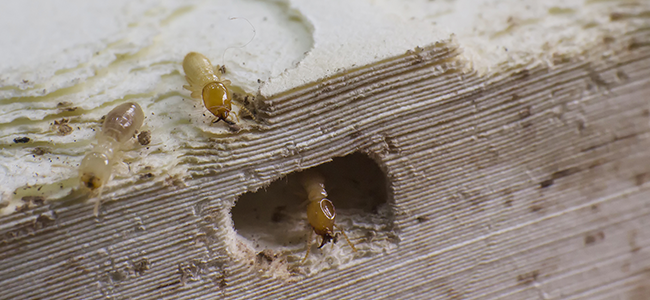
What Every Radford Resident Should Know About Termite Control
01/17/2022
Find out what you need to know about termite control in Radford. ...
READ MORE >

Spring is the time of year when termites start to ramp up their activity in DC-area homes, and summer is when termites do the most damage in our area. That is why it is so important for homeowners to be on guard when it comes to termites this time of year. One of the ways to do this is to learn where these sneaky, destructive insects are likely to target your home.
Subterranean termites go pretty low. They live underground, sometimes, several feet underground. So, when they attack your home, it is going to be in a point that is low to the ground.
• Crawl space. When a home is on concrete piers, a space is created under the home. This space is usually only big enough to crawl around in, that is why it is called a crawl space. If your home has a crawl space, you should know that it is perfect for pest activity, if it has not been properly sealed. When subterranean termites come up into this space, they may establish shelter tubes on your concrete piers (or inside your piers) to get to the wood of your home. If they do, you're in for a world of trouble.
• Soleplate. If your home is on a foundation slab or the concrete walls of a basement, termites may target your soleplate. This is also called the sill. It is the horizontal members of your home that are fastened to the concrete so vertical members can be nailed in place. The closer your soleplate is to the soil, the greater your risk of subterranean termite damage. If you have a soleplate that touches the soil, termites can go in and out of your home without creating shelter tubes. This will increase how much damage they can do to your home and you won't have the warning sign that shelter tubes provide.
• Deck. If you have a deck on your home, this might be the first place subterranean termites target, especially if you have an old deck or an unpainted deck. Subterranean termites prefer wood that is old or decaying but they can target new wood as well, eating the soft wood of the grain.
• Fence Posts. When subterranean termites stumble onto a wooden fence post in the ground, they are more than happy to feed on it. Since they attack the fence below the ground, you're not likely to know you have a problem until your fence is showing a noticeable lean.
• Door and window frames in basement walls. Frames around doors and windows are common trouble areas for moisture and humidity, and even more so for door and window frames that are in basement walls. This can make them a target of subterranean termites. But there is good news. These termites don't prefer hardwood and they will have to create shelter tubes to get to those frames.
• The wood around door and window frames. Often, subterranean termites will bypass the harder wood of your window frames to get to the softer wood that frames your windows. They do this by exploiting damaged seals as other pests do. It is important to make sure all your door and window frames that have a caulk seal around them have a seal that is complete.
When a home is damaged by rainwater, it becomes more susceptible to subterranean termite damage. These insects will thrive when they find soft, moistened wood, especially wood that is rotting. This will allow them to grow their populations faster and increase how many termites are feeding on your home. Two ways moisture damage can occur are:
• Clogged or broken gutters. Your gutters and downspouts are vital for the health of your home. They channel rainwater from your roof out and away from the wooden walls of your home. When rainwater overflows a gutter or splashes against the soleplate of a home because of a break in a downspout pipe, it can lead to wood rot.
• Watering. The plants around your home must be watered in order to survive. When you water your plants you may be watering your house as well. Over time, this can have an impact. This becomes a compound issue if you have dense tree canopy, plants that are too close to your foundation wall, or densely packed vegetation. All of these conditions will keep the water on your walls from drying up and can lead to wood rot.
There are many ways subterranean termites can target your home. That is why professional termite protection is so important. Don't let subterranean termites sneak up on you. Get your protection in place today.

01/17/2022
Find out what you need to know about termite control in Radford. ...
READ MORE >

12/17/2021
Termites can cost you thousands of dollars in repairs. Find out what termite damage looks like in Virginia homes, as well as how to avoid it, by re...
READ MORE >

10/20/2021
What's yellow and white and orange all over? None other than these sneaky insects with a penchant for wooden objects! ...
READ MORE >

08/20/2021
What has six legs, two antennae, and insatiable hunger for wooden items in your home? If you said termites, you'd be right!...
READ MORE >

Protect your home and family from nuisance and potentially damaging pests with a Preferred Care home pest control plan. Starting at $49/month

Don't let the bed bugs bite a second longer. Contact American Pest for the most comprehensive bed bug control in the industry. Learn More

Our certified rodent control pros will put an end to your frustration by getting rid of rats and mice inside your home. Learn More

Say goodbye to wood-destroying termites in your home when you contact American Pest for expert termite control. Learn More

Trust American Pest to deliver professional backyard tick control services that are guaranteed to get results. Learn More

Don't spend the warm-weather season indoors, find out how American Pest's professional treatments get rid of mosquitoes. Learn More
Fill out the form and recieve feedback in less than 5 minutes. For immediate service please call.